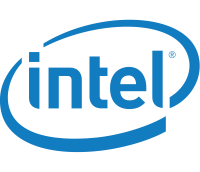
Cancel anytime
- Chart
- Upturn Summary
- Highlights
- Revenue
- Valuation
- Analyst Ratings
 Upturn AI SWOT
Upturn AI SWOT - About
Intel Corporation (INTC)

- BUY Advisory
- SELL Advisory (Profit)
- SELL Advisory (Loss)
- Profit
- Loss
- Pass (Skip investing)

 Stock price based on last close
Stock price based on last close (see disclosures)
- ALL
- YEAR
- MONTH
- WEEK
Upturn Advisory Summary
04/01/2025: INTC (1-star) is currently NOT-A-BUY. Pass it for now.
Analysis of Past Performance
Type Stock | Historic Profit -50.78% | Avg. Invested days 25 | Today’s Advisory PASS |
Upturn Star Rating   | Upturn Advisory Performance | Stock Returns Performance |
Key Highlights
Company Size Large-Cap Stock | Market Capitalization 96.15B USD | Price to earnings Ratio - | 1Y Target Price 22.9 |
Price to earnings Ratio - | 1Y Target Price 22.9 | ||
Volume (30-day avg) 104239063 | Beta 1.02 | 52 Weeks Range 18.51 - 41.22 | Updated Date 04/1/2025 |
52 Weeks Range 18.51 - 41.22 | Updated Date 04/1/2025 | ||
Dividends yield (FY) 2.24% | Basic EPS (TTM) -4.38 |
Analyzing Revenue: Products, Geography and Growth
Revenue by Products
Product revenue - Year on Year
Revenue by Geography
Geography revenue - Year on Year
Earnings Date
Report Date - | When - | Estimate - | Actual - |
Profitability
Profit Margin -35.32% | Operating Margin (TTM) -18.55% |
Management Effectiveness
Return on Assets (TTM) -1.23% | Return on Equity (TTM) -17.89% |
Valuation
Trailing PE - | Forward PE 50 | Enterprise Value 126978036121 | Price to Sales(TTM) 1.81 |
Enterprise Value 126978036121 | Price to Sales(TTM) 1.81 | ||
Enterprise Value to Revenue 2.39 | Enterprise Value to EBITDA 105.55 | Shares Outstanding 4360589824 | Shares Floating 4322292600 |
Shares Outstanding 4360589824 | Shares Floating 4322292600 | ||
Percent Insiders 0.08 | Percent Institutions 66.26 |
Analyst Ratings
Rating 3 | Target Price 24.21 | Buy - | Strong Buy 4 |
Buy - | Strong Buy 4 | ||
Hold 36 | Sell 4 | Strong Sell 2 | |
Strong Sell 2 |
 Upturn AI SWOT
Upturn AI SWOT
Intel Corporation

Company Overview
 History and Background
History and Background
Founded in 1968, Intel Corporation has been a key player in the semiconductor industry, driving innovations in microprocessors and computing technology. Significant milestones include the development of the first microprocessor and its role in the PC revolution. Over time, Intel has expanded into various segments like data centers, AI, and automotive.
 Core Business Areas
Core Business Areas
- Client Computing Group (CCG): Develops and manufactures computing components, including CPUs, chipsets, and related products for desktops, laptops, and mobile devices.
- Data Center and AI (DCAI): Focuses on solutions for data centers, cloud computing, artificial intelligence, and networking infrastructure. This includes server processors, AI accelerators, and network interface cards.
- Network and Edge Group (NEX): Concentrates on network infrastructure, edge computing, and IoT solutions. This includes network processors, Ethernet controllers, and software-defined networking technologies.
- Intel Foundry Services (IFS): Offers manufacturing services to external customers. This will be expanded in the upcoming years.
 Leadership and Structure
Leadership and Structure
Pat Gelsinger is the current CEO. Intel operates with a functional organizational structure divided into business units focused on different product lines and market segments. Key leadership roles also include CFO, CTO, and heads of various business units.
Top Products and Market Share
Key Offerings
- Intel Core Processors: High-performance CPUs for desktops and laptops. Intel holds a significant market share in the CPU market, competing with AMD. Estimated market share is around 60-70% depending on the segment. Competitors: AMD (AMD).
- Intel Xeon Processors: Server-grade CPUs for data centers and cloud computing. These processors are optimized for demanding workloads and scalability. Market share is significant in the server CPU market. Competitors: AMD (AMD).
- Intel Arc Graphics: Discrete GPUs for gaming and content creation. Intel aims to capture a portion of the discrete GPU market, competing with NVIDIA and AMD. Currently, the market share is very small. Competitors: NVIDIA (NVDA), AMD (AMD).
- Intel Optane Persistent Memory: A type of non-volatile memory that offers high performance and persistence for data centers. This solution addresses memory capacity and speed challenges. The product lines have been discontinued so no revenue is being generated. Competitors: Samsung (KRX: 005930), Micron (MU).
Market Dynamics
Industry Overview
The semiconductor industry is characterized by rapid technological advancements, high capital expenditures, and intense competition. Key trends include the growth of AI, cloud computing, IoT, and automotive electronics.
Positioning
Intel Corporation is a leading provider of semiconductor solutions. Its competitive advantages include its established brand, manufacturing capabilities, and extensive product portfolio.
Total Addressable Market (TAM)
The total addressable market for semiconductors is estimated to be hundreds of billions of dollars. Intel is positioned to capture a significant portion of this TAM through its diverse product offerings and strategic investments.
Upturn SWOT Analysis
Strengths
- Strong brand recognition
- Extensive product portfolio
- Manufacturing capabilities
- R&D investments
- Established customer relationships
Weaknesses
- Manufacturing delays and yield issues
- Increased competition from AMD
- High capital expenditures
- Dependence on PC market
- Slower pace of innovation compared to competitors
Opportunities
- Growth in AI and data center markets
- Expansion into automotive and IoT sectors
- Investment in new technologies like chiplets and advanced packaging
- Government incentives for domestic semiconductor manufacturing
- Growth in the foundry business
Threats
- Intense competition from AMD and NVIDIA
- Geopolitical risks and trade tensions
- Supply chain disruptions
- Rapid technological changes
- Economic downturns
Competitors and Market Share
Key Competitors
- AMD
- NVDA
Competitive Landscape
Intel possesses strong manufacturing capabilities, but faces increasing competition from AMD in CPU performance and NVIDIA in GPU innovation. Intel's transition to new process technologies and competition in AI space is key.
Major Acquisitions
Granulate
- Year: 2022
- Acquisition Price (USD millions): 650
- Strategic Rationale: Acquisition of Granulate helps Intel to optimize workload performance and reduce infrastructure costs for its data center customers by leveraging Granulate's real-time optimization software.
Tower Semiconductor
- Year: 2022
- Acquisition Price (USD millions): 5400
- Strategic Rationale: Acquisition of Tower Semiconductor would help Intel to expand their Foundry Services.
Growth Trajectory and Initiatives
Historical Growth: Intel's historical growth has been driven by the PC market and expansion into data centers. Growth rates have fluctuated depending on market conditions and competition.
Future Projections: Future growth projections depend on analyst estimates and Intel's strategic initiatives. These estimates consider market trends, competition, and company-specific factors.
Recent Initiatives: Recent strategic initiatives include investments in new manufacturing technologies, expansion into AI and automotive markets, and the launch of new products.
Summary
Intel is a major player in the semiconductor industry, possessing robust manufacturing and a diverse product line. However, they face intense competition, particularly from AMD and NVIDIA. Their success hinges on overcoming manufacturing challenges and capitalizing on growth opportunities in emerging markets like AI and automotive. Continued innovation is key to regain market share and solidify future performance.
Similar Companies
- AMD
- NVDA
- QCOM
- TSM
- ASML
Sources and Disclaimers
Data Sources:
- Intel Corporation Investor Relations
- SEC Filings
- Industry Reports (e.g., Gartner, IDC)
- Market Research Reports
- Analyst Estimates
Disclaimers:
The information provided is for informational purposes only and should not be considered financial advice. Market conditions and company-specific factors can change rapidly, so it is essential to conduct thorough research and consult with a financial professional before making any investment decisions.

![]() AI Summarization is directionally correct and might not be accurate.
AI Summarization is directionally correct and might not be accurate.

![]() Summarized information shown could be a few years old and not current.
Summarized information shown could be a few years old and not current.

![]() Fundamental Rating based on AI could be based on old data.
Fundamental Rating based on AI could be based on old data.

![]() AI-generated summaries may have inaccuracies (hallucinations). Please verify the information before taking action.
AI-generated summaries may have inaccuracies (hallucinations). Please verify the information before taking action.
About Intel Corporation
Exchange NASDAQ | Headquaters Santa Clara, CA, United States | ||
IPO Launch date 1971-10-13 | CEO & Director Mr. Lip-Bu Tan | ||
Sector Technology | Industry Semiconductors | Full time employees 108900 | Website https://www.intel.com |
Full time employees 108900 | Website https://www.intel.com | ||
Intel Corporation designs, develops, manufactures, markets, and sells computing and related products and services worldwide. The company offers microprocessor and chipset, stand-alone SoC, and multichip package; Computer Systems and Devices; hardware products comprising CPUs, graphics processing units (GPUs), accelerators, and field programmable gate arrays (FPGAs); and memory and storage, connectivity and networking, and other semiconductor products. It also offers silicon and software products; and optimization solutions for workloads, such as AI, cryptography, security, storage, networking, and leverages various features supporting diverse compute environments. In addition, the company provides driving assistance and self-driving solutions; advanced process technologies enabled by an ecosystem of electronic design automation tools, intellectual property, and design services, as well as systems of chips, including advanced packaging technologies, software, and system. Further, it delivers and deploys intelligent edge platforms that allow developers to achieve agility and drive automation using AI for efficient operations with data integrity, as well as provides hardware and software platforms, tools, and ecosystem partnerships for digital transformation from the cloud to edge. The company serves original equipment manufacturers, original design manufacturers, cloud service providers, and other manufacturers and service providers. Intel Corporation was incorporated in 1968 and is headquartered in Santa Clara, California.
Note: This website is maintained by Upturn Corporation, which is an investment adviser registered with the U.S. Securities and Exchange Commission. Such registration does not imply a certain level of skill or training. Investing in securities has risks. Past performance is no guarantee of future returns. No assurance is provided as to any particular investment return, and you may lose money using our services. You are strongly advised to consult appropriate counsel before making any investments in companies you learn about through our services. You should obtain appropriate legal, tax, investment, accounting, and other advice that takes into account your investment portfolio and overall financial situation. You are solely responsible for conducting due diligence on a potential investment. We do not affect trades for you. You will select your own broker through which to transact. Investments are not FDIC insured, they are not guaranteed, and they may lose value. Please see the Privacy Policy, Terms of Use, and Disclosure for more information.


 Home
Home 

